Leadership, Management, and Curriculum in Early Childhood Education
VerifiedAdded on 2022/09/07
|11
|2640
|53
Report
AI Summary
This report delves into the multifaceted aspects of leadership and management within early childhood education (ECE). It begins by defining leadership roles and responsibilities, emphasizing the significance of educators as change agents in shaping children's development. The report then explores various leadership styles, including trait, contingency, and behavioral approaches, and their applications in the ECE context. It connects educational practices with the National Quality Standard (NQS) and the Early Years Learning Framework (EYLF), highlighting the role of educational leaders in curriculum development and the importance of pedagogical leadership. Furthermore, it differentiates between leadership and management, examines the strengths and weaknesses of reflective leadership, and identifies research gaps in the field. The report underscores the critical role of leadership and management in influencing outcomes in ECE.
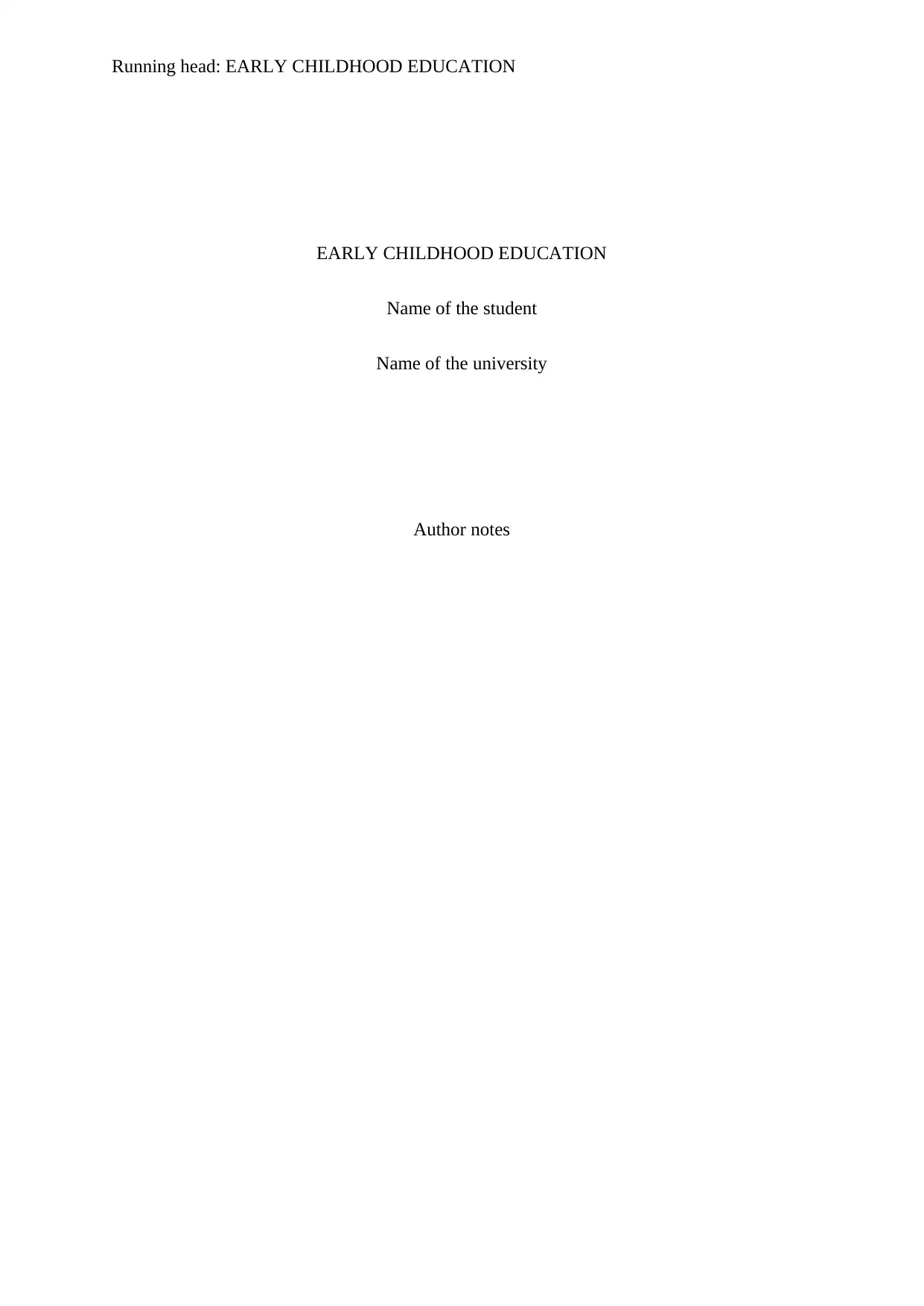
Running head: EARLY CHILDHOOD EDUCATION
EARLY CHILDHOOD EDUCATION
Name of the student
Name of the university
Author notes
EARLY CHILDHOOD EDUCATION
Name of the student
Name of the university
Author notes
Paraphrase This Document
Need a fresh take? Get an instant paraphrase of this document with our AI Paraphraser
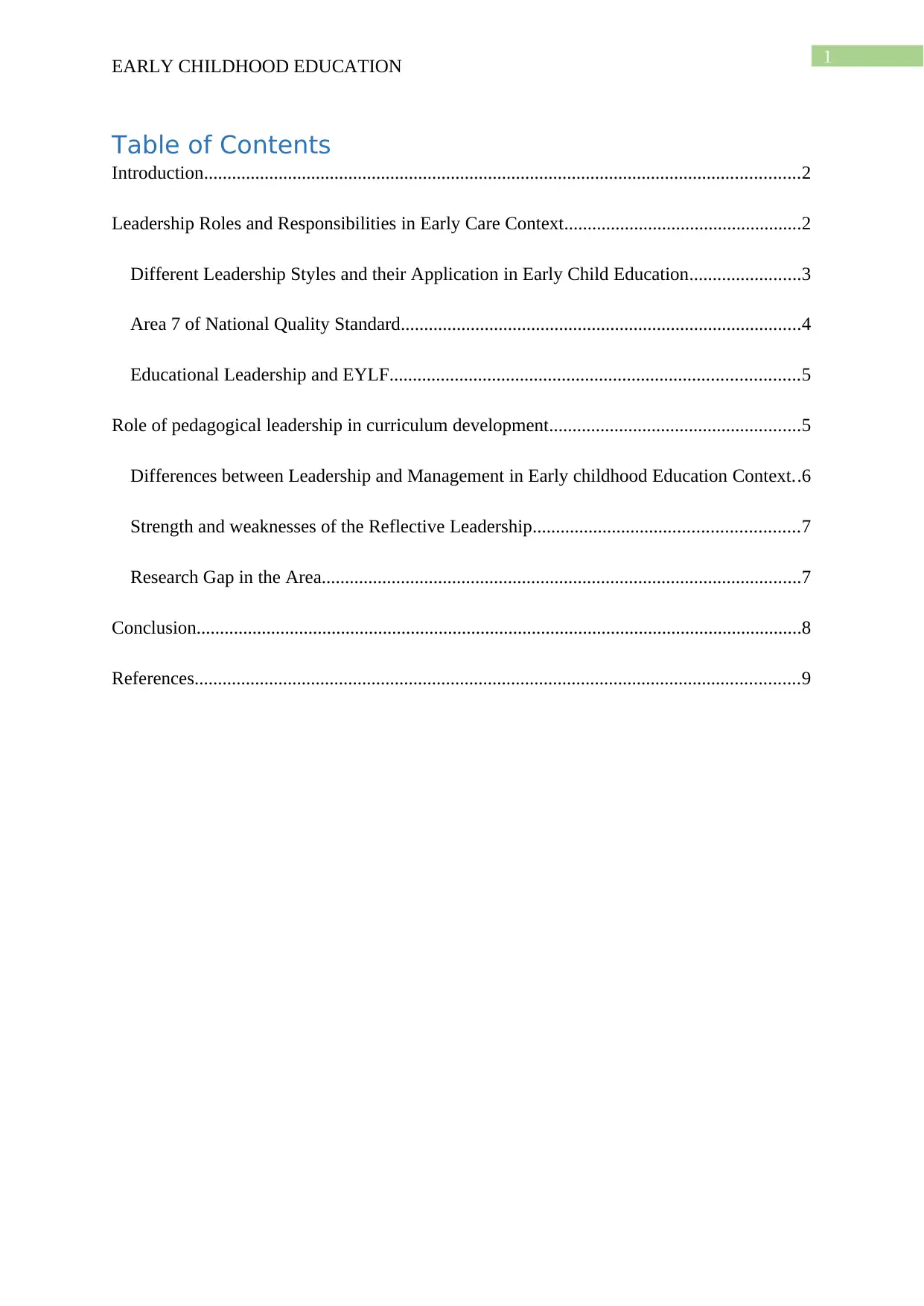
1
EARLY CHILDHOOD EDUCATION
Table of Contents
Introduction................................................................................................................................2
Leadership Roles and Responsibilities in Early Care Context...................................................2
Different Leadership Styles and their Application in Early Child Education........................3
Area 7 of National Quality Standard......................................................................................4
Educational Leadership and EYLF........................................................................................5
Role of pedagogical leadership in curriculum development......................................................5
Differences between Leadership and Management in Early childhood Education Context..6
Strength and weaknesses of the Reflective Leadership.........................................................7
Research Gap in the Area.......................................................................................................7
Conclusion..................................................................................................................................8
References..................................................................................................................................9
EARLY CHILDHOOD EDUCATION
Table of Contents
Introduction................................................................................................................................2
Leadership Roles and Responsibilities in Early Care Context...................................................2
Different Leadership Styles and their Application in Early Child Education........................3
Area 7 of National Quality Standard......................................................................................4
Educational Leadership and EYLF........................................................................................5
Role of pedagogical leadership in curriculum development......................................................5
Differences between Leadership and Management in Early childhood Education Context..6
Strength and weaknesses of the Reflective Leadership.........................................................7
Research Gap in the Area.......................................................................................................7
Conclusion..................................................................................................................................8
References..................................................................................................................................9
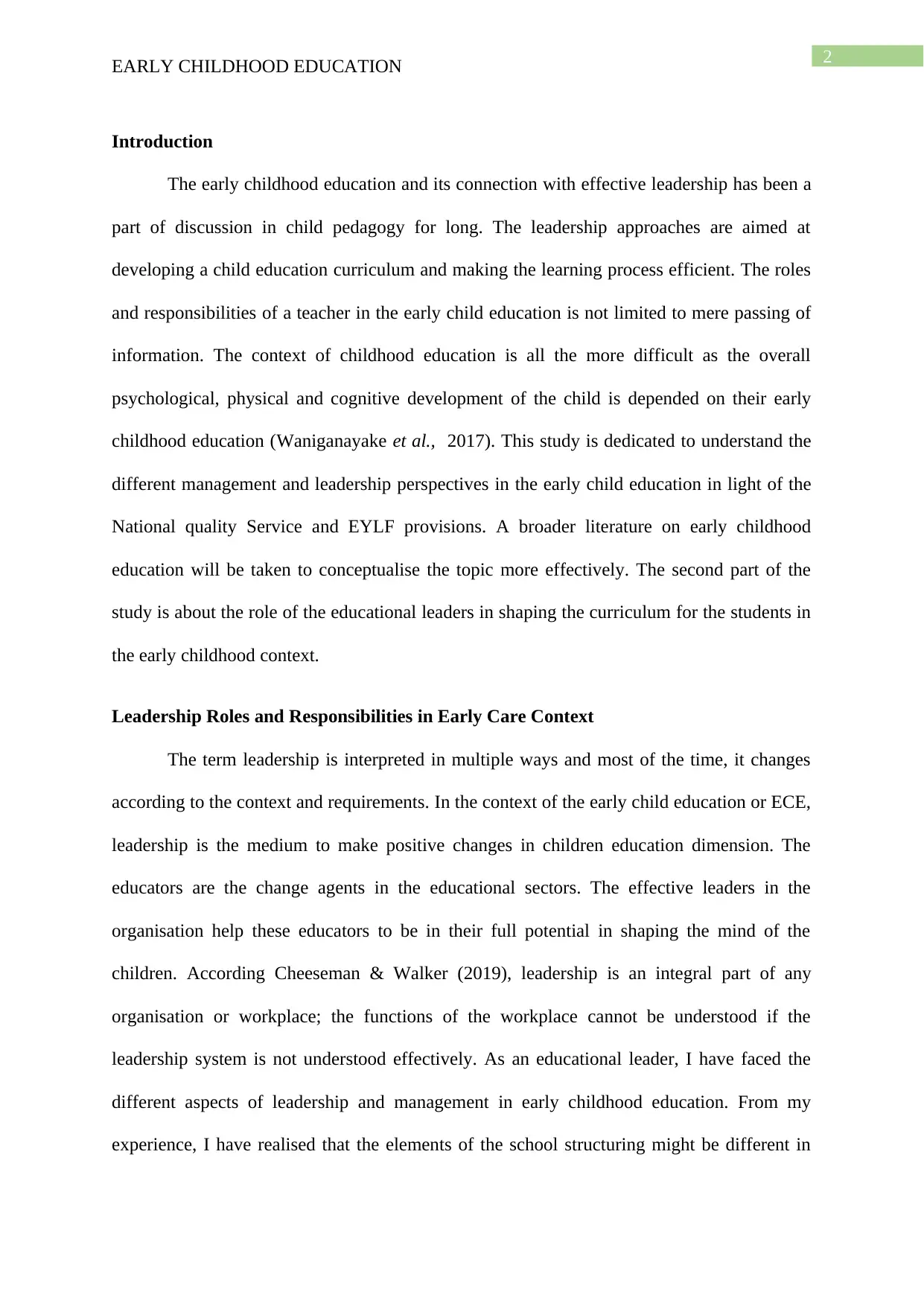
2
EARLY CHILDHOOD EDUCATION
Introduction
The early childhood education and its connection with effective leadership has been a
part of discussion in child pedagogy for long. The leadership approaches are aimed at
developing a child education curriculum and making the learning process efficient. The roles
and responsibilities of a teacher in the early child education is not limited to mere passing of
information. The context of childhood education is all the more difficult as the overall
psychological, physical and cognitive development of the child is depended on their early
childhood education (Waniganayake et al., 2017). This study is dedicated to understand the
different management and leadership perspectives in the early child education in light of the
National quality Service and EYLF provisions. A broader literature on early childhood
education will be taken to conceptualise the topic more effectively. The second part of the
study is about the role of the educational leaders in shaping the curriculum for the students in
the early childhood context.
Leadership Roles and Responsibilities in Early Care Context
The term leadership is interpreted in multiple ways and most of the time, it changes
according to the context and requirements. In the context of the early child education or ECE,
leadership is the medium to make positive changes in children education dimension. The
educators are the change agents in the educational sectors. The effective leaders in the
organisation help these educators to be in their full potential in shaping the mind of the
children. According Cheeseman & Walker (2019), leadership is an integral part of any
organisation or workplace; the functions of the workplace cannot be understood if the
leadership system is not understood effectively. As an educational leader, I have faced the
different aspects of leadership and management in early childhood education. From my
experience, I have realised that the elements of the school structuring might be different in
EARLY CHILDHOOD EDUCATION
Introduction
The early childhood education and its connection with effective leadership has been a
part of discussion in child pedagogy for long. The leadership approaches are aimed at
developing a child education curriculum and making the learning process efficient. The roles
and responsibilities of a teacher in the early child education is not limited to mere passing of
information. The context of childhood education is all the more difficult as the overall
psychological, physical and cognitive development of the child is depended on their early
childhood education (Waniganayake et al., 2017). This study is dedicated to understand the
different management and leadership perspectives in the early child education in light of the
National quality Service and EYLF provisions. A broader literature on early childhood
education will be taken to conceptualise the topic more effectively. The second part of the
study is about the role of the educational leaders in shaping the curriculum for the students in
the early childhood context.
Leadership Roles and Responsibilities in Early Care Context
The term leadership is interpreted in multiple ways and most of the time, it changes
according to the context and requirements. In the context of the early child education or ECE,
leadership is the medium to make positive changes in children education dimension. The
educators are the change agents in the educational sectors. The effective leaders in the
organisation help these educators to be in their full potential in shaping the mind of the
children. According Cheeseman & Walker (2019), leadership is an integral part of any
organisation or workplace; the functions of the workplace cannot be understood if the
leadership system is not understood effectively. As an educational leader, I have faced the
different aspects of leadership and management in early childhood education. From my
experience, I have realised that the elements of the school structuring might be different in
⊘ This is a preview!⊘
Do you want full access?
Subscribe today to unlock all pages.

Trusted by 1+ million students worldwide
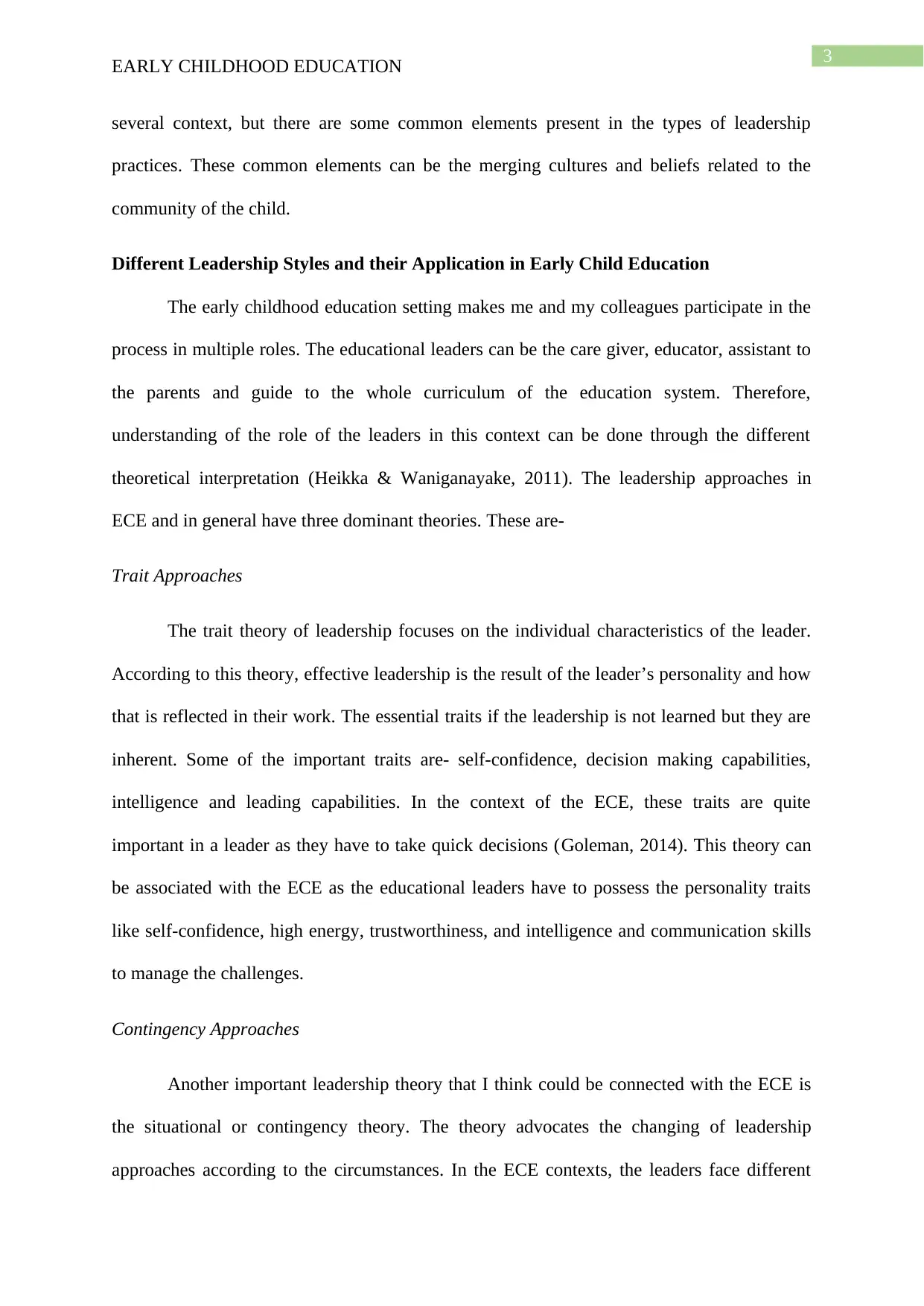
3
EARLY CHILDHOOD EDUCATION
several context, but there are some common elements present in the types of leadership
practices. These common elements can be the merging cultures and beliefs related to the
community of the child.
Different Leadership Styles and their Application in Early Child Education
The early childhood education setting makes me and my colleagues participate in the
process in multiple roles. The educational leaders can be the care giver, educator, assistant to
the parents and guide to the whole curriculum of the education system. Therefore,
understanding of the role of the leaders in this context can be done through the different
theoretical interpretation (Heikka & Waniganayake, 2011). The leadership approaches in
ECE and in general have three dominant theories. These are-
Trait Approaches
The trait theory of leadership focuses on the individual characteristics of the leader.
According to this theory, effective leadership is the result of the leader’s personality and how
that is reflected in their work. The essential traits if the leadership is not learned but they are
inherent. Some of the important traits are- self-confidence, decision making capabilities,
intelligence and leading capabilities. In the context of the ECE, these traits are quite
important in a leader as they have to take quick decisions (Goleman, 2014). This theory can
be associated with the ECE as the educational leaders have to possess the personality traits
like self-confidence, high energy, trustworthiness, and intelligence and communication skills
to manage the challenges.
Contingency Approaches
Another important leadership theory that I think could be connected with the ECE is
the situational or contingency theory. The theory advocates the changing of leadership
approaches according to the circumstances. In the ECE contexts, the leaders face different
EARLY CHILDHOOD EDUCATION
several context, but there are some common elements present in the types of leadership
practices. These common elements can be the merging cultures and beliefs related to the
community of the child.
Different Leadership Styles and their Application in Early Child Education
The early childhood education setting makes me and my colleagues participate in the
process in multiple roles. The educational leaders can be the care giver, educator, assistant to
the parents and guide to the whole curriculum of the education system. Therefore,
understanding of the role of the leaders in this context can be done through the different
theoretical interpretation (Heikka & Waniganayake, 2011). The leadership approaches in
ECE and in general have three dominant theories. These are-
Trait Approaches
The trait theory of leadership focuses on the individual characteristics of the leader.
According to this theory, effective leadership is the result of the leader’s personality and how
that is reflected in their work. The essential traits if the leadership is not learned but they are
inherent. Some of the important traits are- self-confidence, decision making capabilities,
intelligence and leading capabilities. In the context of the ECE, these traits are quite
important in a leader as they have to take quick decisions (Goleman, 2014). This theory can
be associated with the ECE as the educational leaders have to possess the personality traits
like self-confidence, high energy, trustworthiness, and intelligence and communication skills
to manage the challenges.
Contingency Approaches
Another important leadership theory that I think could be connected with the ECE is
the situational or contingency theory. The theory advocates the changing of leadership
approaches according to the circumstances. In the ECE contexts, the leaders face different
Paraphrase This Document
Need a fresh take? Get an instant paraphrase of this document with our AI Paraphraser
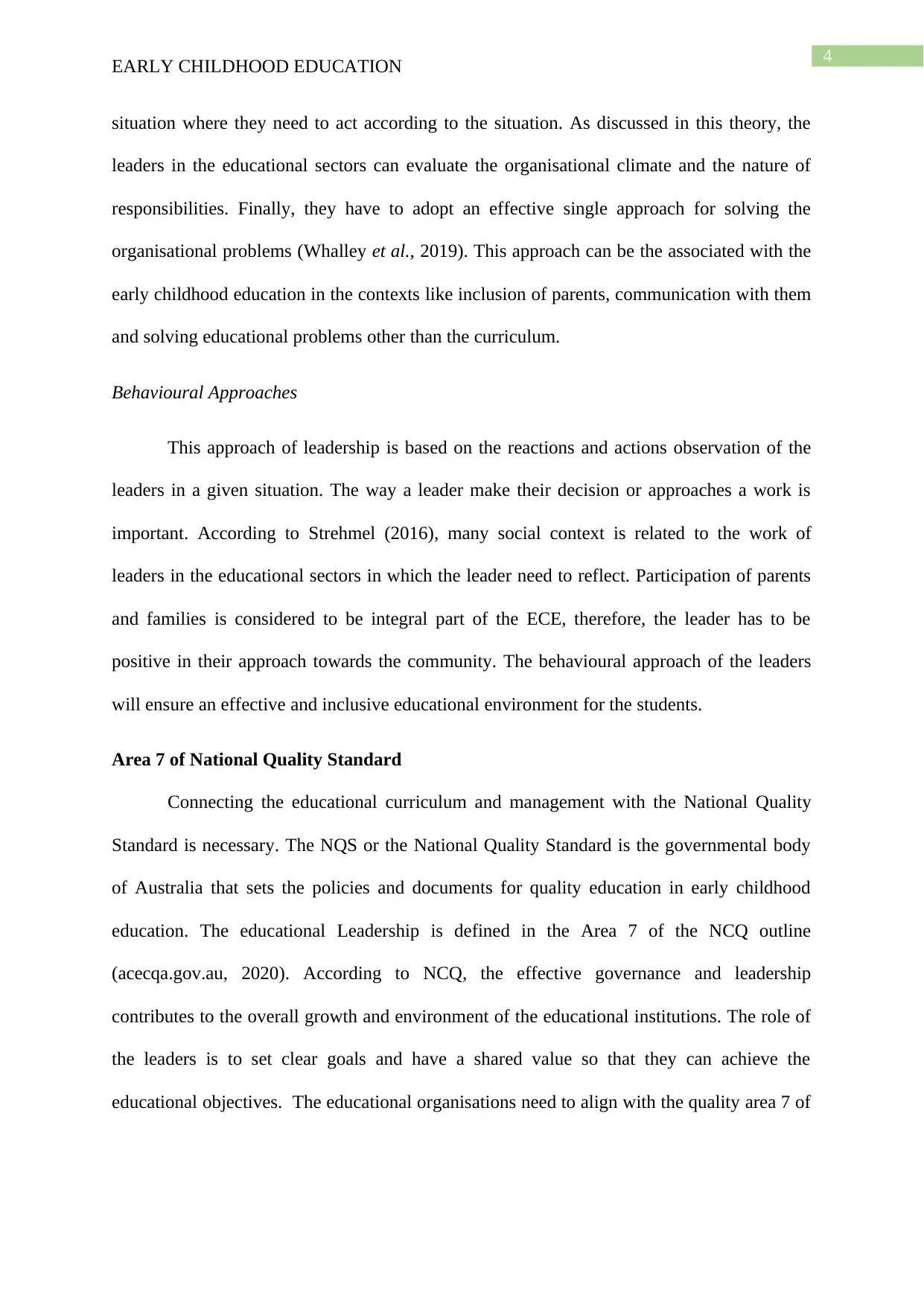
4
EARLY CHILDHOOD EDUCATION
situation where they need to act according to the situation. As discussed in this theory, the
leaders in the educational sectors can evaluate the organisational climate and the nature of
responsibilities. Finally, they have to adopt an effective single approach for solving the
organisational problems (Whalley et al., 2019). This approach can be the associated with the
early childhood education in the contexts like inclusion of parents, communication with them
and solving educational problems other than the curriculum.
Behavioural Approaches
This approach of leadership is based on the reactions and actions observation of the
leaders in a given situation. The way a leader make their decision or approaches a work is
important. According to Strehmel (2016), many social context is related to the work of
leaders in the educational sectors in which the leader need to reflect. Participation of parents
and families is considered to be integral part of the ECE, therefore, the leader has to be
positive in their approach towards the community. The behavioural approach of the leaders
will ensure an effective and inclusive educational environment for the students.
Area 7 of National Quality Standard
Connecting the educational curriculum and management with the National Quality
Standard is necessary. The NQS or the National Quality Standard is the governmental body
of Australia that sets the policies and documents for quality education in early childhood
education. The educational Leadership is defined in the Area 7 of the NCQ outline
(acecqa.gov.au, 2020). According to NCQ, the effective governance and leadership
contributes to the overall growth and environment of the educational institutions. The role of
the leaders is to set clear goals and have a shared value so that they can achieve the
educational objectives. The educational organisations need to align with the quality area 7 of
EARLY CHILDHOOD EDUCATION
situation where they need to act according to the situation. As discussed in this theory, the
leaders in the educational sectors can evaluate the organisational climate and the nature of
responsibilities. Finally, they have to adopt an effective single approach for solving the
organisational problems (Whalley et al., 2019). This approach can be the associated with the
early childhood education in the contexts like inclusion of parents, communication with them
and solving educational problems other than the curriculum.
Behavioural Approaches
This approach of leadership is based on the reactions and actions observation of the
leaders in a given situation. The way a leader make their decision or approaches a work is
important. According to Strehmel (2016), many social context is related to the work of
leaders in the educational sectors in which the leader need to reflect. Participation of parents
and families is considered to be integral part of the ECE, therefore, the leader has to be
positive in their approach towards the community. The behavioural approach of the leaders
will ensure an effective and inclusive educational environment for the students.
Area 7 of National Quality Standard
Connecting the educational curriculum and management with the National Quality
Standard is necessary. The NQS or the National Quality Standard is the governmental body
of Australia that sets the policies and documents for quality education in early childhood
education. The educational Leadership is defined in the Area 7 of the NCQ outline
(acecqa.gov.au, 2020). According to NCQ, the effective governance and leadership
contributes to the overall growth and environment of the educational institutions. The role of
the leaders is to set clear goals and have a shared value so that they can achieve the
educational objectives. The educational organisations need to align with the quality area 7 of
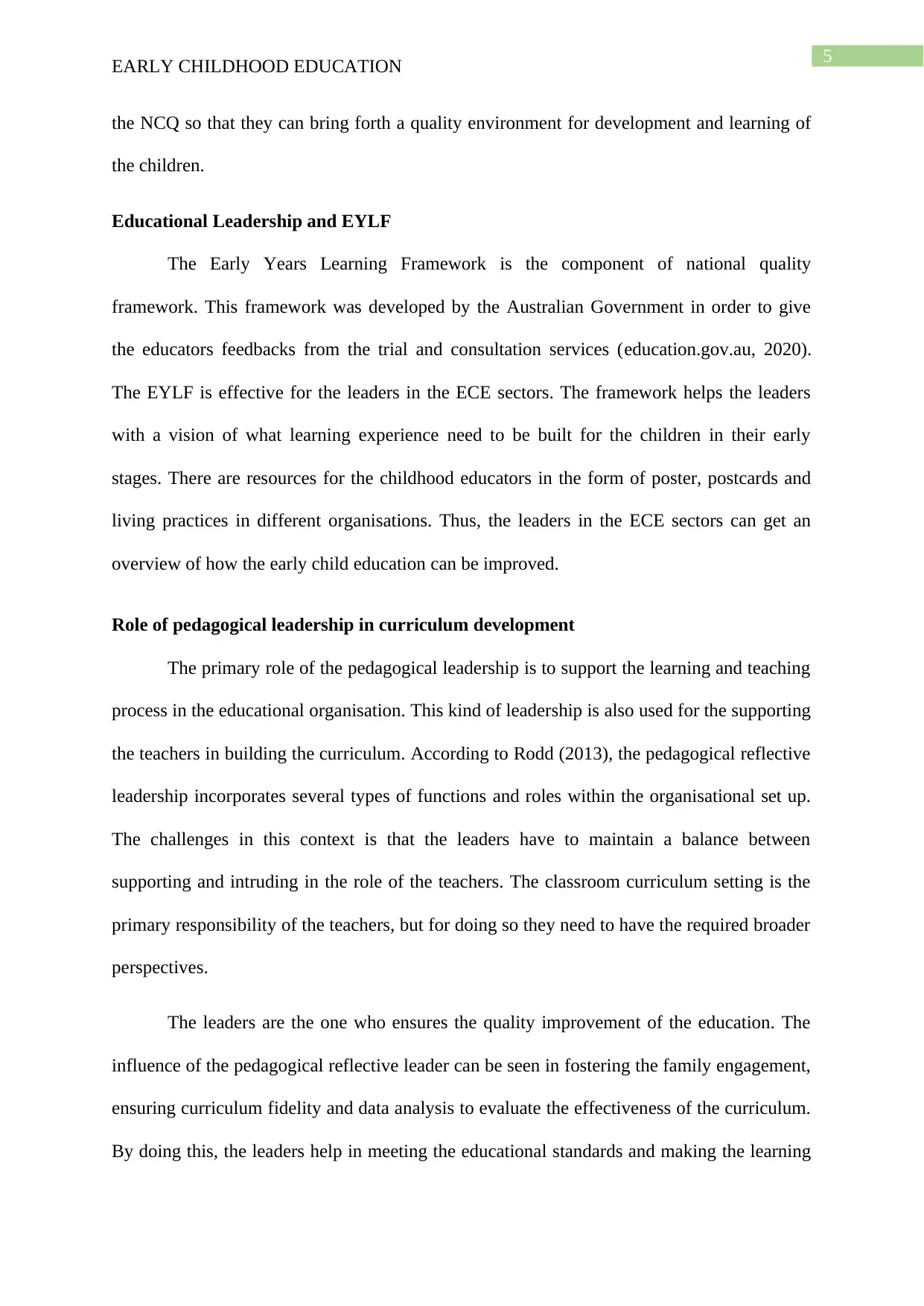
5
EARLY CHILDHOOD EDUCATION
the NCQ so that they can bring forth a quality environment for development and learning of
the children.
Educational Leadership and EYLF
The Early Years Learning Framework is the component of national quality
framework. This framework was developed by the Australian Government in order to give
the educators feedbacks from the trial and consultation services (education.gov.au, 2020).
The EYLF is effective for the leaders in the ECE sectors. The framework helps the leaders
with a vision of what learning experience need to be built for the children in their early
stages. There are resources for the childhood educators in the form of poster, postcards and
living practices in different organisations. Thus, the leaders in the ECE sectors can get an
overview of how the early child education can be improved.
Role of pedagogical leadership in curriculum development
The primary role of the pedagogical leadership is to support the learning and teaching
process in the educational organisation. This kind of leadership is also used for the supporting
the teachers in building the curriculum. According to Rodd (2013), the pedagogical reflective
leadership incorporates several types of functions and roles within the organisational set up.
The challenges in this context is that the leaders have to maintain a balance between
supporting and intruding in the role of the teachers. The classroom curriculum setting is the
primary responsibility of the teachers, but for doing so they need to have the required broader
perspectives.
The leaders are the one who ensures the quality improvement of the education. The
influence of the pedagogical reflective leader can be seen in fostering the family engagement,
ensuring curriculum fidelity and data analysis to evaluate the effectiveness of the curriculum.
By doing this, the leaders help in meeting the educational standards and making the learning
EARLY CHILDHOOD EDUCATION
the NCQ so that they can bring forth a quality environment for development and learning of
the children.
Educational Leadership and EYLF
The Early Years Learning Framework is the component of national quality
framework. This framework was developed by the Australian Government in order to give
the educators feedbacks from the trial and consultation services (education.gov.au, 2020).
The EYLF is effective for the leaders in the ECE sectors. The framework helps the leaders
with a vision of what learning experience need to be built for the children in their early
stages. There are resources for the childhood educators in the form of poster, postcards and
living practices in different organisations. Thus, the leaders in the ECE sectors can get an
overview of how the early child education can be improved.
Role of pedagogical leadership in curriculum development
The primary role of the pedagogical leadership is to support the learning and teaching
process in the educational organisation. This kind of leadership is also used for the supporting
the teachers in building the curriculum. According to Rodd (2013), the pedagogical reflective
leadership incorporates several types of functions and roles within the organisational set up.
The challenges in this context is that the leaders have to maintain a balance between
supporting and intruding in the role of the teachers. The classroom curriculum setting is the
primary responsibility of the teachers, but for doing so they need to have the required broader
perspectives.
The leaders are the one who ensures the quality improvement of the education. The
influence of the pedagogical reflective leader can be seen in fostering the family engagement,
ensuring curriculum fidelity and data analysis to evaluate the effectiveness of the curriculum.
By doing this, the leaders help in meeting the educational standards and making the learning
⊘ This is a preview!⊘
Do you want full access?
Subscribe today to unlock all pages.

Trusted by 1+ million students worldwide
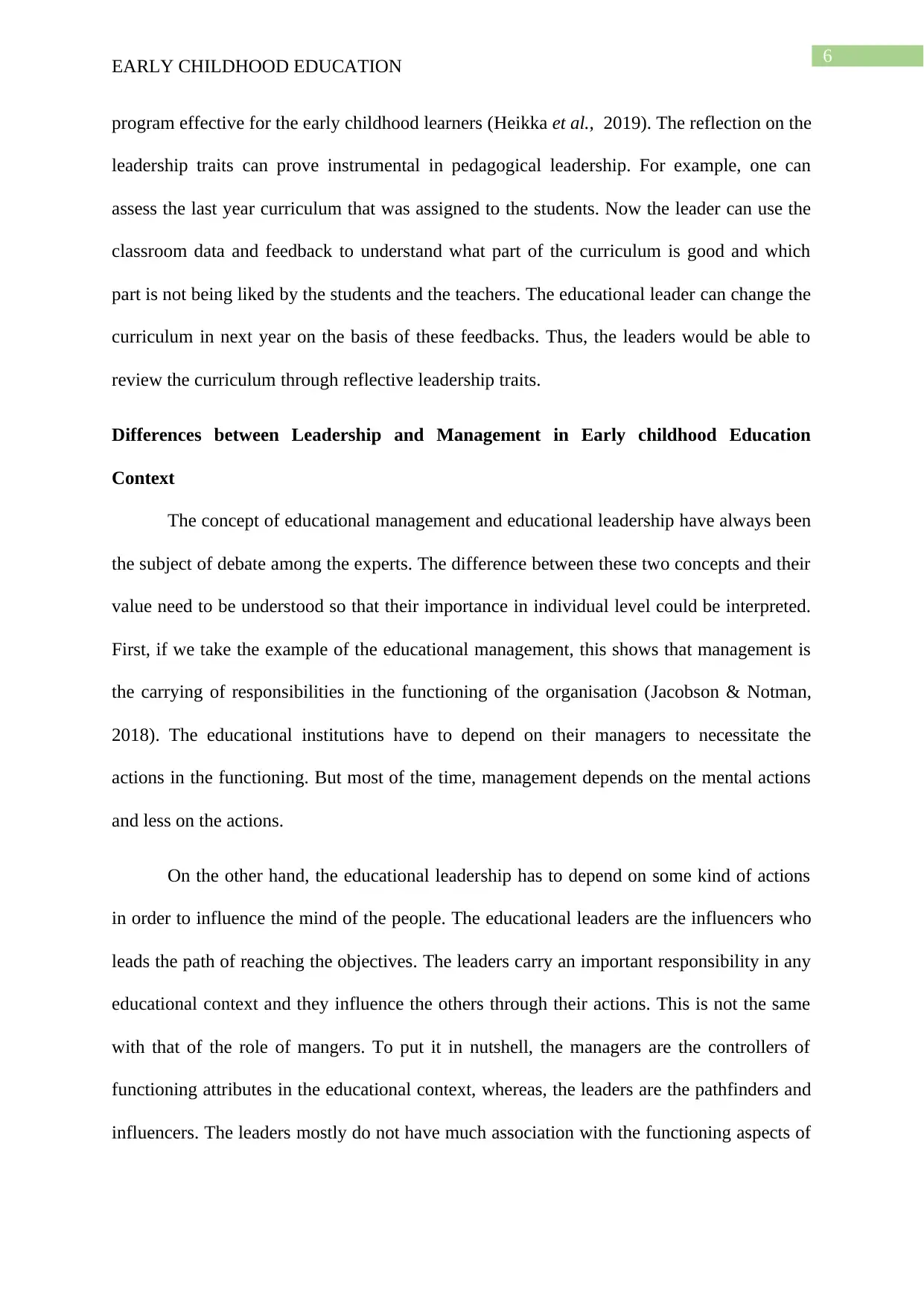
6
EARLY CHILDHOOD EDUCATION
program effective for the early childhood learners (Heikka et al., 2019). The reflection on the
leadership traits can prove instrumental in pedagogical leadership. For example, one can
assess the last year curriculum that was assigned to the students. Now the leader can use the
classroom data and feedback to understand what part of the curriculum is good and which
part is not being liked by the students and the teachers. The educational leader can change the
curriculum in next year on the basis of these feedbacks. Thus, the leaders would be able to
review the curriculum through reflective leadership traits.
Differences between Leadership and Management in Early childhood Education
Context
The concept of educational management and educational leadership have always been
the subject of debate among the experts. The difference between these two concepts and their
value need to be understood so that their importance in individual level could be interpreted.
First, if we take the example of the educational management, this shows that management is
the carrying of responsibilities in the functioning of the organisation (Jacobson & Notman,
2018). The educational institutions have to depend on their managers to necessitate the
actions in the functioning. But most of the time, management depends on the mental actions
and less on the actions.
On the other hand, the educational leadership has to depend on some kind of actions
in order to influence the mind of the people. The educational leaders are the influencers who
leads the path of reaching the objectives. The leaders carry an important responsibility in any
educational context and they influence the others through their actions. This is not the same
with that of the role of mangers. To put it in nutshell, the managers are the controllers of
functioning attributes in the educational context, whereas, the leaders are the pathfinders and
influencers. The leaders mostly do not have much association with the functioning aspects of
EARLY CHILDHOOD EDUCATION
program effective for the early childhood learners (Heikka et al., 2019). The reflection on the
leadership traits can prove instrumental in pedagogical leadership. For example, one can
assess the last year curriculum that was assigned to the students. Now the leader can use the
classroom data and feedback to understand what part of the curriculum is good and which
part is not being liked by the students and the teachers. The educational leader can change the
curriculum in next year on the basis of these feedbacks. Thus, the leaders would be able to
review the curriculum through reflective leadership traits.
Differences between Leadership and Management in Early childhood Education
Context
The concept of educational management and educational leadership have always been
the subject of debate among the experts. The difference between these two concepts and their
value need to be understood so that their importance in individual level could be interpreted.
First, if we take the example of the educational management, this shows that management is
the carrying of responsibilities in the functioning of the organisation (Jacobson & Notman,
2018). The educational institutions have to depend on their managers to necessitate the
actions in the functioning. But most of the time, management depends on the mental actions
and less on the actions.
On the other hand, the educational leadership has to depend on some kind of actions
in order to influence the mind of the people. The educational leaders are the influencers who
leads the path of reaching the objectives. The leaders carry an important responsibility in any
educational context and they influence the others through their actions. This is not the same
with that of the role of mangers. To put it in nutshell, the managers are the controllers of
functioning attributes in the educational context, whereas, the leaders are the pathfinders and
influencers. The leaders mostly do not have much association with the functioning aspects of
Paraphrase This Document
Need a fresh take? Get an instant paraphrase of this document with our AI Paraphraser
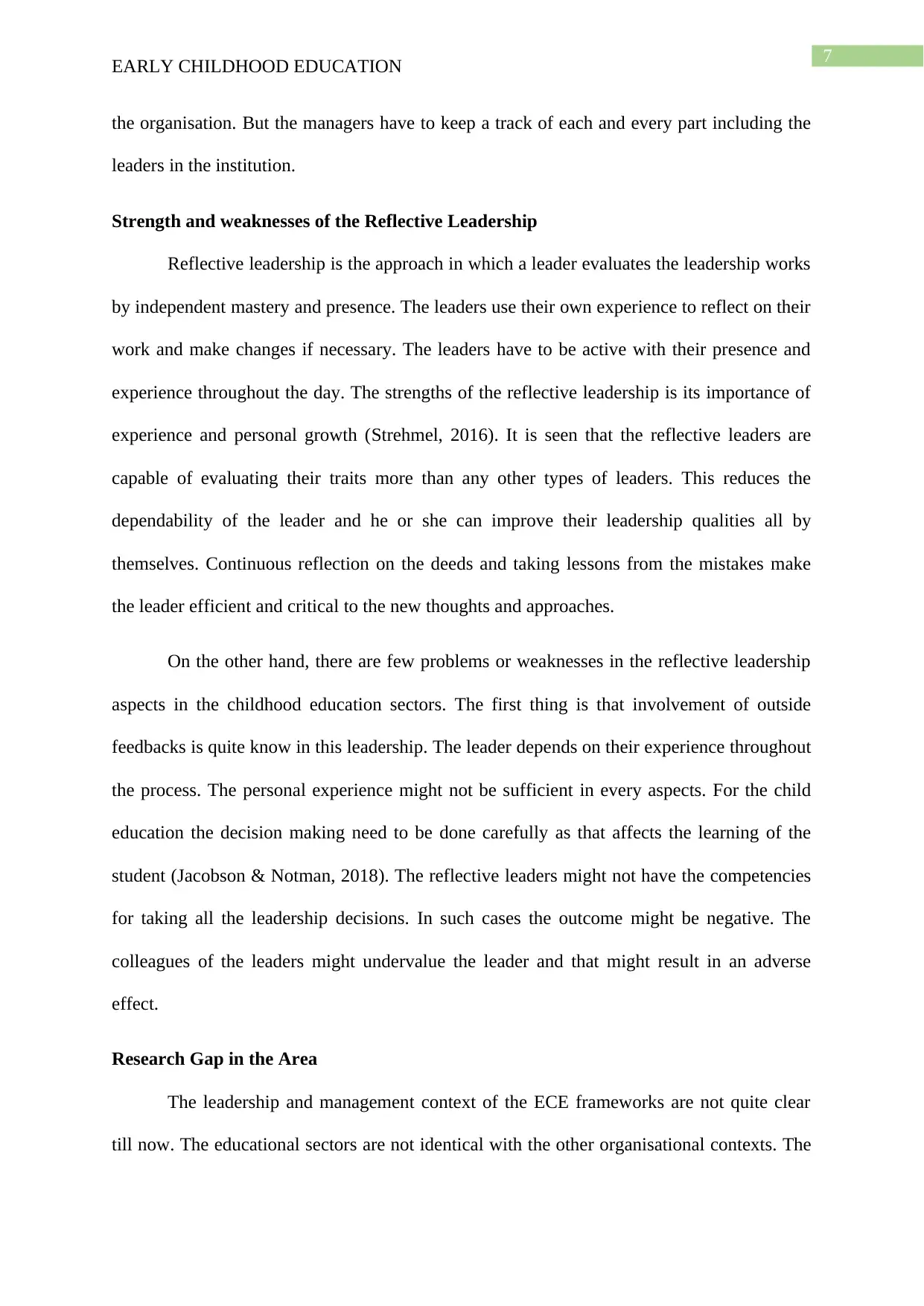
7
EARLY CHILDHOOD EDUCATION
the organisation. But the managers have to keep a track of each and every part including the
leaders in the institution.
Strength and weaknesses of the Reflective Leadership
Reflective leadership is the approach in which a leader evaluates the leadership works
by independent mastery and presence. The leaders use their own experience to reflect on their
work and make changes if necessary. The leaders have to be active with their presence and
experience throughout the day. The strengths of the reflective leadership is its importance of
experience and personal growth (Strehmel, 2016). It is seen that the reflective leaders are
capable of evaluating their traits more than any other types of leaders. This reduces the
dependability of the leader and he or she can improve their leadership qualities all by
themselves. Continuous reflection on the deeds and taking lessons from the mistakes make
the leader efficient and critical to the new thoughts and approaches.
On the other hand, there are few problems or weaknesses in the reflective leadership
aspects in the childhood education sectors. The first thing is that involvement of outside
feedbacks is quite know in this leadership. The leader depends on their experience throughout
the process. The personal experience might not be sufficient in every aspects. For the child
education the decision making need to be done carefully as that affects the learning of the
student (Jacobson & Notman, 2018). The reflective leaders might not have the competencies
for taking all the leadership decisions. In such cases the outcome might be negative. The
colleagues of the leaders might undervalue the leader and that might result in an adverse
effect.
Research Gap in the Area
The leadership and management context of the ECE frameworks are not quite clear
till now. The educational sectors are not identical with the other organisational contexts. The
EARLY CHILDHOOD EDUCATION
the organisation. But the managers have to keep a track of each and every part including the
leaders in the institution.
Strength and weaknesses of the Reflective Leadership
Reflective leadership is the approach in which a leader evaluates the leadership works
by independent mastery and presence. The leaders use their own experience to reflect on their
work and make changes if necessary. The leaders have to be active with their presence and
experience throughout the day. The strengths of the reflective leadership is its importance of
experience and personal growth (Strehmel, 2016). It is seen that the reflective leaders are
capable of evaluating their traits more than any other types of leaders. This reduces the
dependability of the leader and he or she can improve their leadership qualities all by
themselves. Continuous reflection on the deeds and taking lessons from the mistakes make
the leader efficient and critical to the new thoughts and approaches.
On the other hand, there are few problems or weaknesses in the reflective leadership
aspects in the childhood education sectors. The first thing is that involvement of outside
feedbacks is quite know in this leadership. The leader depends on their experience throughout
the process. The personal experience might not be sufficient in every aspects. For the child
education the decision making need to be done carefully as that affects the learning of the
student (Jacobson & Notman, 2018). The reflective leaders might not have the competencies
for taking all the leadership decisions. In such cases the outcome might be negative. The
colleagues of the leaders might undervalue the leader and that might result in an adverse
effect.
Research Gap in the Area
The leadership and management context of the ECE frameworks are not quite clear
till now. The educational sectors are not identical with the other organisational contexts. The
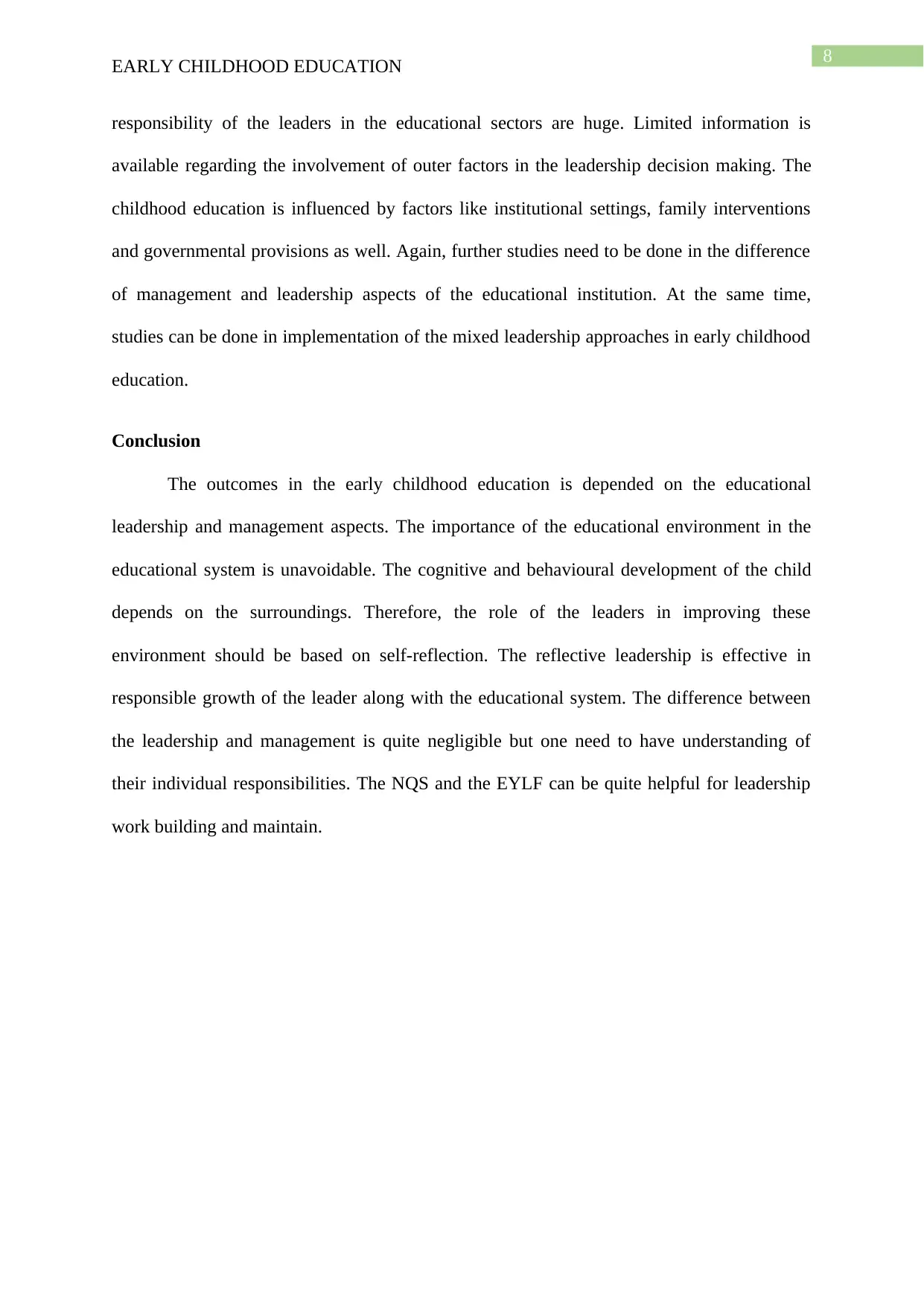
8
EARLY CHILDHOOD EDUCATION
responsibility of the leaders in the educational sectors are huge. Limited information is
available regarding the involvement of outer factors in the leadership decision making. The
childhood education is influenced by factors like institutional settings, family interventions
and governmental provisions as well. Again, further studies need to be done in the difference
of management and leadership aspects of the educational institution. At the same time,
studies can be done in implementation of the mixed leadership approaches in early childhood
education.
Conclusion
The outcomes in the early childhood education is depended on the educational
leadership and management aspects. The importance of the educational environment in the
educational system is unavoidable. The cognitive and behavioural development of the child
depends on the surroundings. Therefore, the role of the leaders in improving these
environment should be based on self-reflection. The reflective leadership is effective in
responsible growth of the leader along with the educational system. The difference between
the leadership and management is quite negligible but one need to have understanding of
their individual responsibilities. The NQS and the EYLF can be quite helpful for leadership
work building and maintain.
EARLY CHILDHOOD EDUCATION
responsibility of the leaders in the educational sectors are huge. Limited information is
available regarding the involvement of outer factors in the leadership decision making. The
childhood education is influenced by factors like institutional settings, family interventions
and governmental provisions as well. Again, further studies need to be done in the difference
of management and leadership aspects of the educational institution. At the same time,
studies can be done in implementation of the mixed leadership approaches in early childhood
education.
Conclusion
The outcomes in the early childhood education is depended on the educational
leadership and management aspects. The importance of the educational environment in the
educational system is unavoidable. The cognitive and behavioural development of the child
depends on the surroundings. Therefore, the role of the leaders in improving these
environment should be based on self-reflection. The reflective leadership is effective in
responsible growth of the leader along with the educational system. The difference between
the leadership and management is quite negligible but one need to have understanding of
their individual responsibilities. The NQS and the EYLF can be quite helpful for leadership
work building and maintain.
⊘ This is a preview!⊘
Do you want full access?
Subscribe today to unlock all pages.

Trusted by 1+ million students worldwide
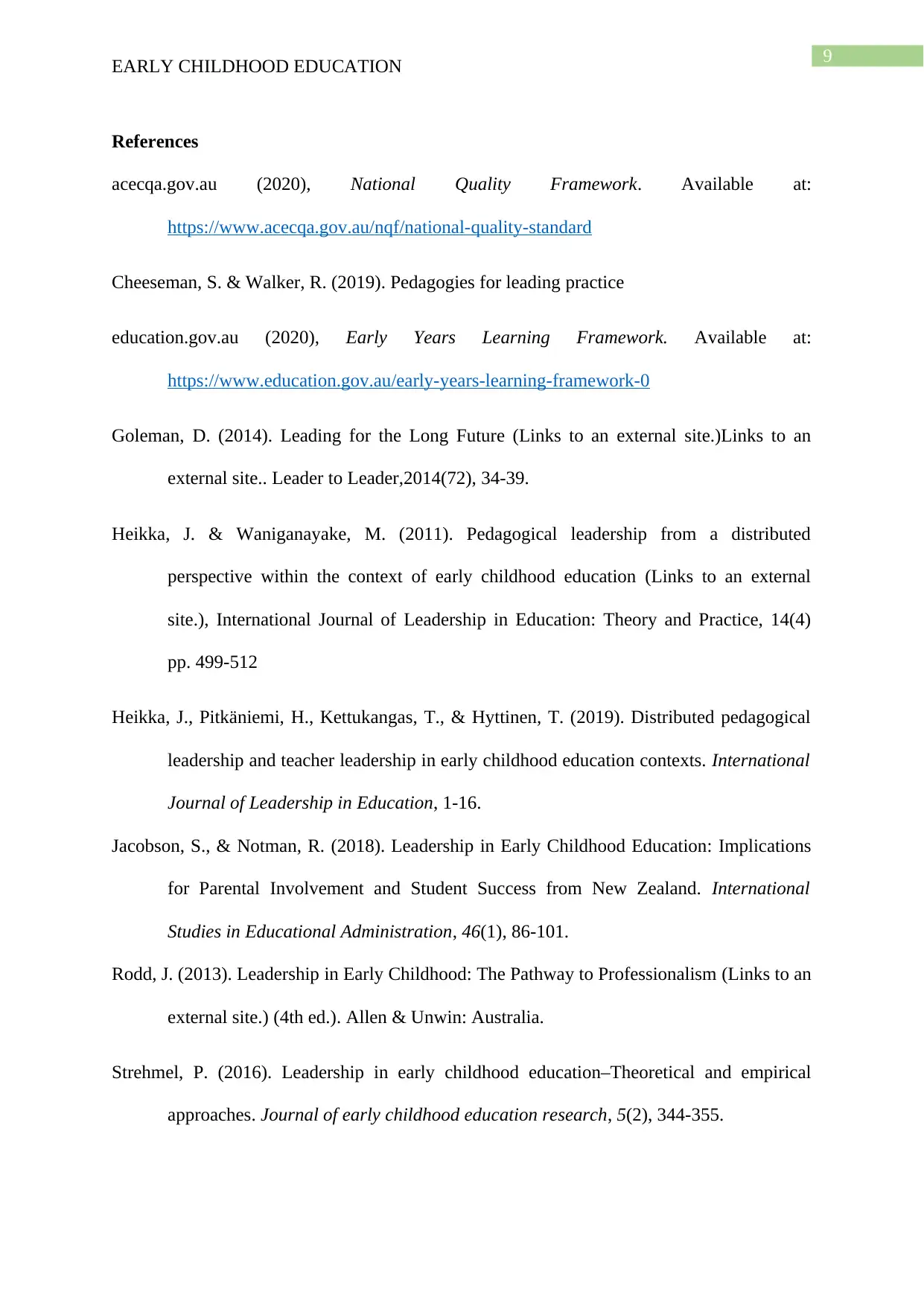
9
EARLY CHILDHOOD EDUCATION
References
acecqa.gov.au (2020), National Quality Framework. Available at:
https://www.acecqa.gov.au/nqf/national-quality-standard
Cheeseman, S. & Walker, R. (2019). Pedagogies for leading practice
education.gov.au (2020), Early Years Learning Framework. Available at:
https://www.education.gov.au/early-years-learning-framework-0
Goleman, D. (2014). Leading for the Long Future (Links to an external site.)Links to an
external site.. Leader to Leader,2014(72), 34-39.
Heikka, J. & Waniganayake, M. (2011). Pedagogical leadership from a distributed
perspective within the context of early childhood education (Links to an external
site.), International Journal of Leadership in Education: Theory and Practice, 14(4)
pp. 499-512
Heikka, J., Pitkäniemi, H., Kettukangas, T., & Hyttinen, T. (2019). Distributed pedagogical
leadership and teacher leadership in early childhood education contexts. International
Journal of Leadership in Education, 1-16.
Jacobson, S., & Notman, R. (2018). Leadership in Early Childhood Education: Implications
for Parental Involvement and Student Success from New Zealand. International
Studies in Educational Administration, 46(1), 86-101.
Rodd, J. (2013). Leadership in Early Childhood: The Pathway to Professionalism (Links to an
external site.) (4th ed.). Allen & Unwin: Australia.
Strehmel, P. (2016). Leadership in early childhood education–Theoretical and empirical
approaches. Journal of early childhood education research, 5(2), 344-355.
EARLY CHILDHOOD EDUCATION
References
acecqa.gov.au (2020), National Quality Framework. Available at:
https://www.acecqa.gov.au/nqf/national-quality-standard
Cheeseman, S. & Walker, R. (2019). Pedagogies for leading practice
education.gov.au (2020), Early Years Learning Framework. Available at:
https://www.education.gov.au/early-years-learning-framework-0
Goleman, D. (2014). Leading for the Long Future (Links to an external site.)Links to an
external site.. Leader to Leader,2014(72), 34-39.
Heikka, J. & Waniganayake, M. (2011). Pedagogical leadership from a distributed
perspective within the context of early childhood education (Links to an external
site.), International Journal of Leadership in Education: Theory and Practice, 14(4)
pp. 499-512
Heikka, J., Pitkäniemi, H., Kettukangas, T., & Hyttinen, T. (2019). Distributed pedagogical
leadership and teacher leadership in early childhood education contexts. International
Journal of Leadership in Education, 1-16.
Jacobson, S., & Notman, R. (2018). Leadership in Early Childhood Education: Implications
for Parental Involvement and Student Success from New Zealand. International
Studies in Educational Administration, 46(1), 86-101.
Rodd, J. (2013). Leadership in Early Childhood: The Pathway to Professionalism (Links to an
external site.) (4th ed.). Allen & Unwin: Australia.
Strehmel, P. (2016). Leadership in early childhood education–Theoretical and empirical
approaches. Journal of early childhood education research, 5(2), 344-355.
Paraphrase This Document
Need a fresh take? Get an instant paraphrase of this document with our AI Paraphraser
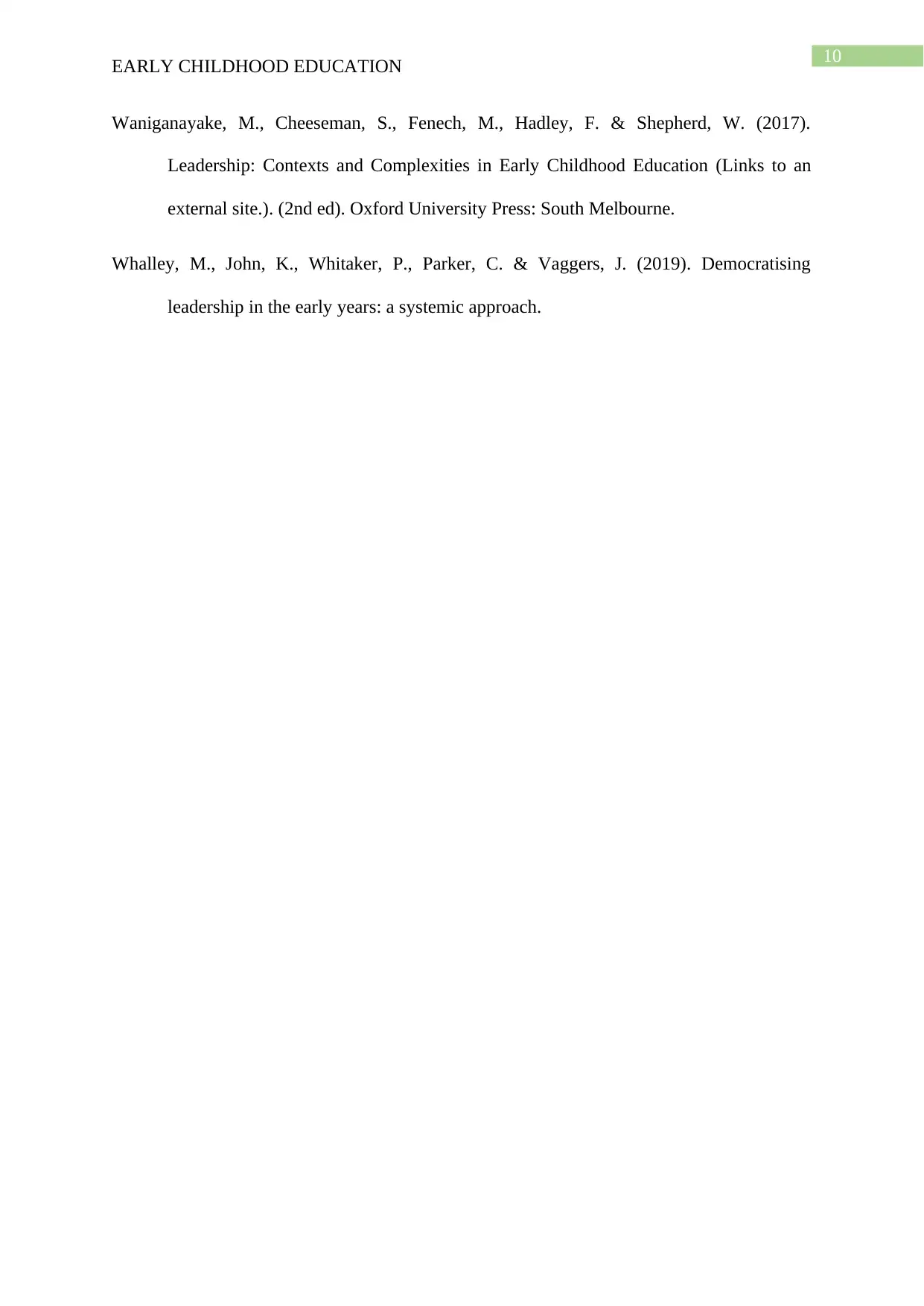
10
EARLY CHILDHOOD EDUCATION
Waniganayake, M., Cheeseman, S., Fenech, M., Hadley, F. & Shepherd, W. (2017).
Leadership: Contexts and Complexities in Early Childhood Education (Links to an
external site.). (2nd ed). Oxford University Press: South Melbourne.
Whalley, M., John, K., Whitaker, P., Parker, C. & Vaggers, J. (2019). Democratising
leadership in the early years: a systemic approach.
EARLY CHILDHOOD EDUCATION
Waniganayake, M., Cheeseman, S., Fenech, M., Hadley, F. & Shepherd, W. (2017).
Leadership: Contexts and Complexities in Early Childhood Education (Links to an
external site.). (2nd ed). Oxford University Press: South Melbourne.
Whalley, M., John, K., Whitaker, P., Parker, C. & Vaggers, J. (2019). Democratising
leadership in the early years: a systemic approach.
1 out of 11
Related Documents
Your All-in-One AI-Powered Toolkit for Academic Success.
+13062052269
info@desklib.com
Available 24*7 on WhatsApp / Email
![[object Object]](/_next/static/media/star-bottom.7253800d.svg)
Unlock your academic potential
Copyright © 2020–2025 A2Z Services. All Rights Reserved. Developed and managed by ZUCOL.





